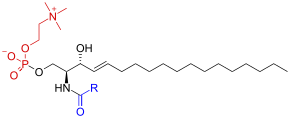Sphingomyelin

Sphingomyelin (SPH, ˌsfɪŋɡoˈmaɪəlɪn) is a type of
Sphingomyelin was first isolated by German chemist Johann L.W. Thudicum in the 1880s.[3] The structure of sphingomyelin was first reported in 1927 as N-acyl-sphingosine-1-phosphorylcholine.[3] Sphingomyelin content in mammals ranges from 2 to 15% in most tissues, with higher concentrations found in nerve tissues, red blood cells, and the ocular lenses. Sphingomyelin has significant structural and functional roles in the cell. It is a plasma membrane component and participates in many signaling pathways. The metabolism of sphingomyelin creates many products that play significant roles in the cell.[3]
Physical characteristics

Black: Sphingosine
Red: Phosphocholine
Blue: Fatty acid

Composition
Sphingomyelin consists of a
Sphingomyelin obtained from natural sources, such as eggs or bovine brain, contains fatty acids of various chain length. Sphingomyelin with set chain length, such as palmitoylsphingomyelin with a saturated 16 acyl chain, is available commercially.[4]
Properties
Ideally, sphingomyelin molecules are shaped like a cylinder, however many molecules of sphingomyelin have a significant chain mismatch (the lengths of the two hydrophobic chains are significantly different).[5] The hydrophobic chains of sphingomyelin tend to be much more saturated than other phospholipids. The main transition phase temperature of sphingomyelins is also higher compared to the phase transition temperature of similar phospholipids, near 37 °C. This can introduce lateral heterogeneity in the membrane, generating domains in the membrane bilayer.[5]
Sphingomyelin undergoes significant interactions with cholesterol. Cholesterol has the ability to eliminate the liquid to solid phase transition in phospholipids. Due to sphingomyelin transition temperature being within physiological temperature ranges, cholesterol can play a significant role in the phase of sphingomyelin. Sphingomyelin are also more prone to intermolecular hydrogen bonding than other phospholipids.[6]
Location
Sphingomyelin is synthesized at the
Metabolism
Synthesis
The synthesis of sphingomyelin involves the enzymatic transfer of a phosphocholine from

Degradation
Sphingomyelin breakdown is responsible for initiating many universal signaling pathways. It is hydrolyzed by sphingomyelinases (sphingomyelin specific type-C phospholipases).[7] The phosphocholine head group is released into the aqueous environment while the ceramide diffuses through the membrane.
Function
Membranes
The membranous
Signal transduction
The function of sphingomyelin remained unclear until it was found to have a role in signal transduction.[13] It has been discovered that sphingomyelin plays a significant role in cell signaling pathways. The synthesis of sphingomyelin at the plasma membrane by sphingomyelin synthase 2 produces diacylglycerol, which is a lipid-soluble second messenger that can pass along a signal cascade. In addition, the degradation of sphingomyelin can produce ceramide which is involved in the apoptotic signaling pathway.
Apoptosis
Sphingomyelin has been found to have a role in cell apoptosis by hydrolyzing into ceramide. Studies in the late 1990s had found that ceramide was produced in a variety of conditions leading to apoptosis.[14] It was then hypothesized that sphingomyelin hydrolysis and ceramide signaling were essential in the decision of whether a cell dies. In the early 2000s new studies emerged that defined a new role for sphingomyelin hydrolysis in apoptosis, determining not only when a cell dies but how.[14] After more experimentation it has been shown that if sphingomyelin hydrolysis happens at a sufficiently early point in the pathway the production of ceramide may influence either the rate and form of cell death or work to release blocks on downstream events.[14]
Lipid rafts
Sphingomyelin, as well as other sphingolipids, are associated with lipid microdomains in the plasma membrane known as lipid rafts. Lipid rafts are characterized by the lipid molecules being in the lipid ordered phase, offering more structure and rigidity compared to the rest of the plasma membrane. In the rafts, the acyl chains have low chain motion but the molecules have high lateral mobility. This order is in part due to the higher transition temperature of sphingolipids as well as the interactions of these lipids with cholesterol. Cholesterol is a relatively small, nonpolar molecule that can fill the space between the sphingolipids that is a result of the large acyl chains. Lipid rafts are thought to be involved in many cell processes, such as membrane sorting and trafficking, signal transduction, and cell polarization.[15] Excessive sphingomyelin in lipid rafts may lead to insulin resistance.[16]
Due to the specific types of lipids in these microdomains, lipid rafts can accumulate certain types of proteins associated with them, thereby increasing the special functions they possess. Lipid rafts have been speculated to be involved in the cascade of cell apoptosis.[17]
Abnormalities and associated diseases
Sphingomyelin can accumulate in a rare
As a result of the autoimmune disease
An excess of sphingomyelin in the red blood cell membrane (as in
Additional images
-
Ball-and-stick model of sphingomyelin
-
Skeletal formula of sphingomyelin
References
- ^ PMID 16386304.
- ^ ISBN 978-0470-23396-2.
- ^ S2CID 35378780.

- ^ "Avanti Polar Lipids". Archived from the original on 2014-03-29. Retrieved 2013-07-16.
- ^ PMID 11001558.
- PMID 11342156.

- ^ PMID 9009829.
- PMID 11062253.
- PMID 16905542.

- PMID 8089120.
- PMID 9092485.
- PMID 17349629.
- S2CID 30521415.
- ^ PMID 10893276.
- PMID 15231303.
- PMID 21844222.
- PMID 16337303.
- PMID 20607622.
External links
- Sphingomyelins at the U.S. National Library of Medicine Medical Subject Headings (MeSH)

